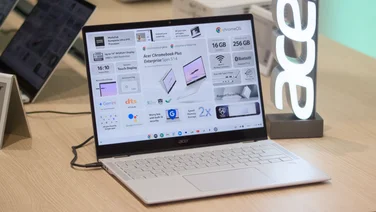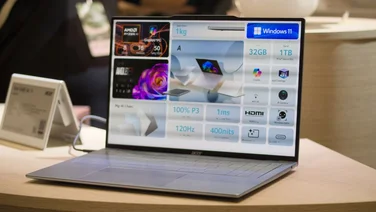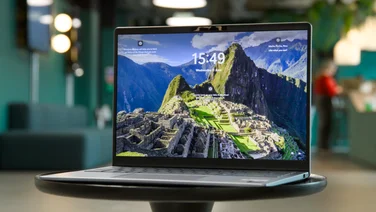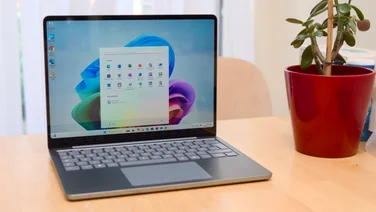To help us provide you with free impartial advice, we may earn a commission if you buy through links on our site. Learn more

The Toshiba Satellite L50-B-1DV comes in a very bold shade of red that might not be to everyone’s taste but we thought its vibrant and eye-catching design made the laptop look reasonably attractive from the outside. It uses a red glossy plastic chassis that has a speckled, almost carbon fibre-like patterning that extends from the external lid to the inside base around the keyboard, and the touchpad comes in a contrasting pastel shade of red. Surprisingly, smudges and greasy fingerprints aren’t as big a problem as you might expect.
Surrounding the screen is a glossy black bezel that isn’t overly thick. However, where the display joins with the base, Toshiba has used a matt black plastic that is also used for the keyboard keys that is a slightly different shade of black. Between the bezel, the top of the hinge, the base, and the touchpad there’s a mix of materials and colours that make the design slightly too busy and inconsistent.
Weighing 2.2kg, the Satellite L50 is about average for a 15.6in laptop, and at 23.5mm thick it’s not too hefty. It exhibited some flex in the lid and internal chassis and we also found the screen’s hinge was slightly unstable, meaning the display wobbled slightly when pushed. This didn’t cause any problems during everyday use, however.
The Toshiba Satellite L50 has one USB2 port and two USB3 ports. The Satellite L50 also supports sleep and charge, so one of the USB3 ports remains powered even when the laptop is in sleep mode or shut down, so you can still charge a device such as a smartphone. You also have VGA and HDMI connections, so if you need to you can easily connect the laptop to an external display or projector.
The Chiclet-style keyboard is well spaced but the keys have too little travel to them for our taste. This made typing comfortably and accurately difficult. The cursor keys are also half-height so are slightly fiddly to use as well. There is at least very little flex to the keyboard, which is always good to see.
The touchpad uses a matt coating that means there’s some resistance, so your fingers might not slide across smoothly but was otherwise responsive. While tapping to click was fine, the integrated mouse buttons are stiff and we found them frustrating and difficult to use.
Processing power is provided by a dual-core 1.6GHz Intel Core-i5 4200U that supports Intel Turbo Boost up to 2.6GHz under certain thermal conditions. It is supported by a generous 8GB of RAM and this should be more than ample for everyday use but if you do need more there is a second vacant slot and the motherboard supports up to 16GB so it’s simply a matter of installing a second module. The Satellite L50 also has a very spacious 1TB hard disk, so you’ll have ample space for your media, applications and documents.
In our application 2D benchmarks, the Satellite L50 managed an overall score of 28 for image editing, video transcoding and multitasking. This was disappointing and less than we have seen from this processor in the past. It will still be sufficient for most everyday computing tasks like web browsing, document editing and watching movies, however.
The integrated Intel HD 4400 graphics processor is ill-equipped for any serious gaming, which is a shame. In Dirt Showdown at 1,280×720, 4x anti-aliasing and High graphics quality we only saw 18fps, which is too slow to be playable. The system fared better in our Trine 2 test, and we saw 40fps when playing the game at 1,280×720, no anti-aliasing and Very Low graphics. So provided you’re willing to drop the image quality considerably you’ll get by with some light gaming.
The Satellite L50 uses a 1,366×768 display that is serviceable but slightly underwhelming. Our display calibration tests showed it had a black level reading of 0.60cd/m2 and a contrast ratio of 350:1. The Satellite L50’s coverage of the sRGB colour gamut was about average for the price, at only 57.5 per cent coverage. This means the display isn’t a good option for those involved in colour sensitive work such as photography. In our subjective image tests we found that the colours were less washed out compared to the Asus X553MA and viewing angles were acceptable without too much colour shift. We didn’t have any issues with backlight bleed as well.
Overall, the Toshiba Satellite L50 wasn’t as fast as we’d hope it would be. The Dell Inspiron 15 5000 is the better choice if you can afford it, as it provided better performance and had a superior keyboard and touchpad.






